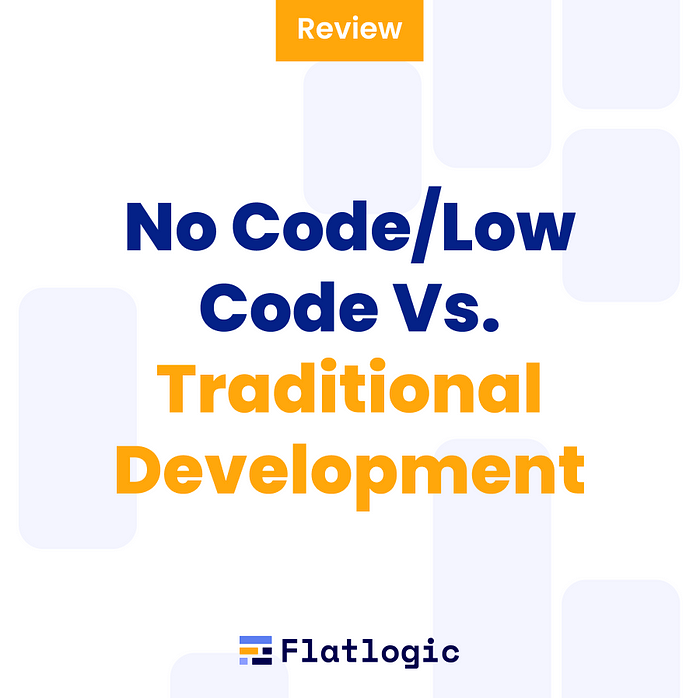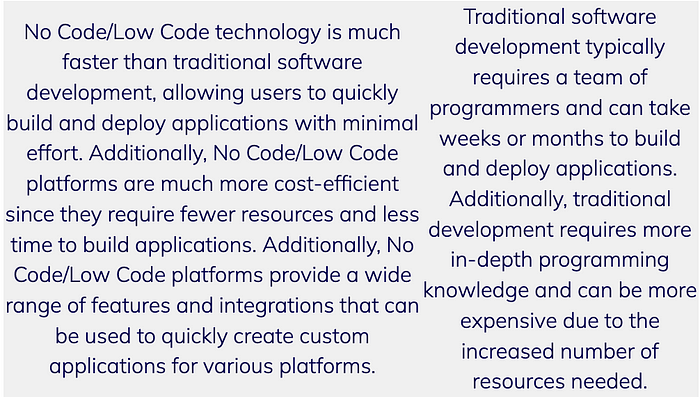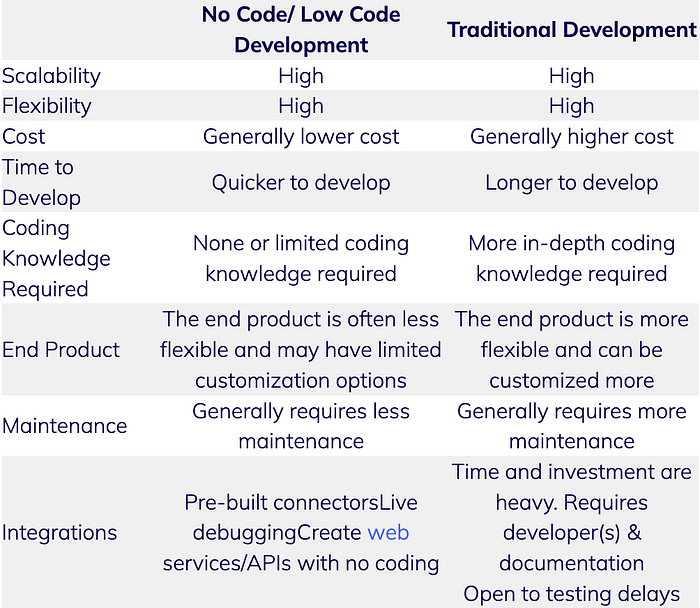No Code/Low Code Vs. Traditional Development

Do you want to know which is better — No Code/Low Code or Traditional Development? Are you looking for the advantages and disadvantages of each? Do you need to know how to choose between them? And interested in the implications of development time and cost?
The debate between No Code/Low Code and Traditional Development has been ongoing for some time now. The need to create and deploy software quickly and cost-effectively has never been greater for businesses of all sizes. Many organizations are struggling to decide which approach to take when it comes to software development.
By reading this article, you will make an informed decision about which approach is best for your project. You will learn about the advantages and disadvantages of each, and how they can affect your development process. You’ll also learn how development time and expense affect the overall success of your project.
What is No Code/Low Code?
No Code/Low Code technology is a kind of infrastructure for software development that enables users to create websites and mobile apps without having any prior coding experience. It is designed for organization consumers and developers that are looking for a more rapid, more efficient way to create apps across several platforms. Platforms with No Code or Low Code support drag-and-drop features making it simple to create and deploy programs quickly. Additionally, these platforms offer some features and relationships that may be used to construct and edit programs.

Where Do No-code/Low-code Platforms Work Best?
No-code/low-code platforms may be the perfect option for businesses and other entities wishing to build apps for unique business use cases in the absence of a conventional solution. However, keep in mind that these are basic principles, and the ideal method is to assess and apply the solution within the context of the individual company objectives and goals.
Can No Code/Low Code and Traditional Development Be Used Together?
No code/low code and traditional programming are not incompatible and can cooperate to make a digital project successful. Organizations may speed up development and control expenses by using no code or little code to design a system’s fundamental functionality. The most intricate, customized functionality can then be developed by bringing in professional programming teams. A further benefit of no code/low code is that it democratizes application development by empowering ‘citizen developers’ with business expertise to produce practical and usable apps without the requirement for conventional programming. Additionally, this frees up expert programmers so they may concentrate on other coding-related activities.
Benefits Of No-code/Low-code Development
Benefit #1 Reduced Costs
Low-code development services can significantly reduce time and costs for enterprises while also eliminating the need to hire as many developers. Opting for no-code development for your product offers the added benefit of flexibility through the Agile method, which supports versioning for any application edits.
Benefit #2 Flexibility
Businesses can develop and make changes faster with low-code development. Compared to custom development, creating low-code/no-code products requires fewer skills because they offer configuration-based design experiences.
Benefit #3 Efficient Risk Management
By using a no-code/low-code approach, businesses can easily adapt to changes in regulations and remain compliant. Furthermore, processes like code writing, compiling, and debugging are considerably faster than traditional development methods.
Benefit #4 Enhanced Customer Experience
Automated low-code and no-code platforms streamline crucial operations to enhance the customer experience. These platforms are highly agile in application development and offer strong business process capabilities, resulting in the creation of high-quality apps that ultimately improve the overall customer experience.
Benefit #5 Enhanced Productivity
Platforms with low- or no code allow IT and business teams to collaborate to find genuine solutions for business issues. This method enables business teams to create their apps without the aid of developers, speeding up the development process. Additionally, it lessens the requirement for intricate coding, allowing for the participation of more team members and boosting output.
Benefit #6 Security
New patches and upgrades will be installed automatically in low-code/no-code platforms instead of by developers manually.
No Code/Low Code Vs. Traditional Development
The combination of low-code and traditional development can bring numerous benefits to both the business and project delivery teams. These advantages include enhanced efficiency, improved user experience, and faster time-to-market. Nevertheless, it is essential to acknowledge the significant differences between the two approaches.
Determining System Requirements
When considering the system requirements for a project, there are significant differences between no code/low code development and traditional programming. Traditional coding involves selecting a specific programming language, environment, and device before beginning the project. For instance, an Android app cannot easily be transferred to a Mac OS desktop solution. Therefore, companies that use traditional coding must make extra efforts to ensure their system works across various operating systems. In contrast, no code/low code development eliminates this problem by using drag-and-drop visual interfaces that can run across multiple operating systems. Some platforms also offer tools for managing requirements and errors, making them ideal for agile development. Applications built with no code/low code can be adapted to various operating systems and devices, regardless of complexity. This is not possible with traditional programming, giving no code/low code platforms a market advantage in building large-scale and scalable systems with seamless adaptability and native development capability.
DevOps Automation
Deploying traditional applications can be a complex and time-consuming process. Each line of code must be tested in a non-production environment before it can be used in the production environment, and application instances must be checked for compatibility with their assigned configuration. However, using a no-code/low-code platform can eliminate some deployment stages. For example, no code/low code modules and their functionalities are tested thoroughly before being added to the platform, reducing testing time. The no code/low code development environment is also cloud-based, making the testing process more efficient and straightforward.
Maintenance & Support
It can be difficult to maintain or update traditional programming applications when business objectives and requirements change. This often means having to write completely new code, which can slow down business innovation and make it harder to meet customer expectations. For instance, if data analysis recommends adding a new feature to the application, the development team would need to step in. Additionally, issues with data center configuration would require manual fixes. These are some of the main reasons why applications become outdated and are considered legacy software as technology and operating systems progress. No code/low code software development can help alleviate these concerns. With a visual interface module managed by the platform provider, making changes to the solution is simplified, and the application design is optimized for ideal performance.
No Code/Low Code vs. Traditional Development: Differences

Low-code and no-code platforms allow for quick app development with easy-to-use drag-and-drop interfaces, while custom app development uses traditional methods to create robust apps. These two approaches have distinct differences.
Difference #1 Skill-Sets
Creating complex applications traditionally requires extensive technical skills and a variety of tools and functions. However, low-code/no-code platforms simplify the process by providing a smaller set of tools that can be used to create a variety of applications with ease. This enables non-technical staff to develop applications without needing extensive technical skills.
Difference #2 Quality
Due to their highly technical and complex nature, custom application development platforms can often result in a large number of bugs, making them difficult to use. In contrast, business low-code/no-code platforms generally do not generate bugs, leading to the creation of applications that run smoothly and are free from any hassles.
Difference #3 Cost
Developing traditional custom software can be quite expensive, with costs ranging from $40,000 to $250,000, depending on the project scope and company needs. In comparison, low-code/no-code solutions are a more affordable option, with companies only paying for access to the service instead of the entire development process. This makes them an attractive choice for larger businesses in need of highly customized software.
Difference #4 Flexibility
Low-code platforms offer a more flexible development experience compared to traditional ones, thanks to their user-friendly drag-and-drop features. This means users need not invest as much time in learning and operating them as they would with complex code-based systems. Additionally, low-code platforms eliminate the need for coding when developing applications, allowing users to simply use drawing methods to achieve the same result.
Difference #5 Maintenance
Maintaining software through traditional coding processes can be tedious, especially when revisions are necessary. This requires a specialized development team to plan, design, and test the changes before training users on the new updates. Fortunately, low-code platforms simplify maintenance as the hosting company manages all updates and improvements. This means even small or IT department-less businesses can enjoy well-maintained software without needing third-party vendors or in-house teams.
Summing Up — So, Which is Better?
The answer to the question No code/low code vs. traditional development: which is better? is not as straightforward as you may think. Traditional programming still has a lot to offer in terms of flexibility and customizability, even while low-code platforms undoubtedly provide numerous benefits in terms of expediting application delivery. Thus, it depends upon the company’s particular requirements and objectives. The choice to combine the two strategies is also an option, though. When traditional programming and low-code platforms are used together, businesses may benefit from low-code speed and creativity while still being able to create specialized solutions. The development of top-notch, business-grade solutions that combine the greatest features of both worlds is made possible as a result.
